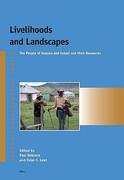2 - Making a Living in Contemporary Rural South Africa
Corresponding Author(s) : Maano Ramutsindela
Revue africaine des livres,
Vol. 4 No 1 (2008): Revue africaine des Livres, volume 4, n° 1, 2008
Résumé
Livelihoods and Landscapes: The People of Guquka and Koloni and their Resources by Paul Hebinck and Peter Lent (eds) Brill, 2007, 387 pp, ISBN 978 90 04 16169 6
Researchers and commentators have variously been intrigued by the connection between people and landscapes, especially in rural environments, where such connections have remained intact despite the huge impact of industrialisation and modernisation on society. Accounts for the people-landscape nexus reveal that humans contributed to shaping existing landscapes and adapted their livelihood strategies to changing landscapes. The interconnectedness of people and their rural landscapes has largely been projected as a sign of backwardness. Such projections are clear from images of Africa and its people, which have historically been linked to the livelihoods of rural inhabitants as if all people in the continent live in rural areas and under similar conditions. Mudimbe clearly articulated those images and their link to rural environments in the following words: ‘from … the insistent image of the African continent as a “refused place” arise: a hot piece of land on which pathetic beings live on roots, herbs and carmel’s milk; a monstrous place and, therefore … a place where madness and melancholia reign supreme’...
Mots-clés
- James Fairhead and Melissa Leach, Misreading the African Landscape, Cambridge MA, Cambridge University Press, 1996; James McCann, Green Land, Brown Land, Black Land: An Environmental History of Africa, 1800-1990, Portsmouth NH, Heinemann, 1999.
- Valentin Mudimbe, The Idea of Africa, Bloomington, Indiana University Press, 1988.
- Robert Murray, Mister Africa: The Story of African Car Hire and Trans Africa Safaris and the Development of Overland Touring from Cape Town to the Nile, Cape Town, Murray, 1996.
- Colin Bundy, The Rise and Fall of the South African Peasantry, Oxford, James Currey, 1988.
- Isak Niehaus, Witchcraft, Power and Politics: Exploring the Occult in the South African Lowveld, London, Pluto Press, 2001.
- Norman Levy, The Foundations of the South African Cheap Labour System, London, Routledge and Kegan Paul, 1982.
- The consequences of the loss of land were worsened by mass killing of cattle following Nongqawuse’s prophecy.
- De Wet provides a useful definition of betterment planning as ‘attempts by successive South African Governments to combat erosion, conserve the environment and develop agriculture in the “homelands”, and so also cut down on urbanisation, and in some phases even migrant labour, thereby keeping more black people in the homelands’ (Chris de Wet, ‘Betterment Planning in a Rural Village in Keiskammahoek, Ciskei’, Journal of Southern African Studies, 15 (1989), pp. 326-345.
- The purpose of the Tomlinson Commission was to advise government on the socio-economic development of black areas. The Commission’s Report of 1955 suggested plans for the consolidation of scattered reserves, because the existing areas had no foundation for community development and growth (see Anthony Christopher, The Atlas of Apartheid, London, Routledge, 1994).
- In 1990, private enterprise managed 8.6 million hectares and, by 2003, game ranching covered some 17 million hectares.
- Timm Hoffman and Ally Ashwell, Nature Divided: Land Degradation in South Africa, Cape Town, University of Cape Town Press, 2001.
- Maano Ramutsindela, ‘Resilient geographies: land, boundaries and the consolidation of the former bantustans in post-1994 South Africa’, Geographical Journal 173(2007), pp. 43-55.
Les références
James Fairhead and Melissa Leach, Misreading the African Landscape, Cambridge MA, Cambridge University Press, 1996; James McCann, Green Land, Brown Land, Black Land: An Environmental History of Africa, 1800-1990, Portsmouth NH, Heinemann, 1999.
Valentin Mudimbe, The Idea of Africa, Bloomington, Indiana University Press, 1988.
Robert Murray, Mister Africa: The Story of African Car Hire and Trans Africa Safaris and the Development of Overland Touring from Cape Town to the Nile, Cape Town, Murray, 1996.
Colin Bundy, The Rise and Fall of the South African Peasantry, Oxford, James Currey, 1988.
Isak Niehaus, Witchcraft, Power and Politics: Exploring the Occult in the South African Lowveld, London, Pluto Press, 2001.
Norman Levy, The Foundations of the South African Cheap Labour System, London, Routledge and Kegan Paul, 1982.
The consequences of the loss of land were worsened by mass killing of cattle following Nongqawuse’s prophecy.
De Wet provides a useful definition of betterment planning as ‘attempts by successive South African Governments to combat erosion, conserve the environment and develop agriculture in the “homelands”, and so also cut down on urbanisation, and in some phases even migrant labour, thereby keeping more black people in the homelands’ (Chris de Wet, ‘Betterment Planning in a Rural Village in Keiskammahoek, Ciskei’, Journal of Southern African Studies, 15 (1989), pp. 326-345.
The purpose of the Tomlinson Commission was to advise government on the socio-economic development of black areas. The Commission’s Report of 1955 suggested plans for the consolidation of scattered reserves, because the existing areas had no foundation for community development and growth (see Anthony Christopher, The Atlas of Apartheid, London, Routledge, 1994).
In 1990, private enterprise managed 8.6 million hectares and, by 2003, game ranching covered some 17 million hectares.
Timm Hoffman and Ally Ashwell, Nature Divided: Land Degradation in South Africa, Cape Town, University of Cape Town Press, 2001.
Maano Ramutsindela, ‘Resilient geographies: land, boundaries and the consolidation of the former bantustans in post-1994 South Africa’, Geographical Journal 173(2007), pp. 43-55.
